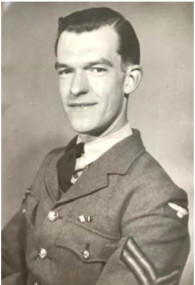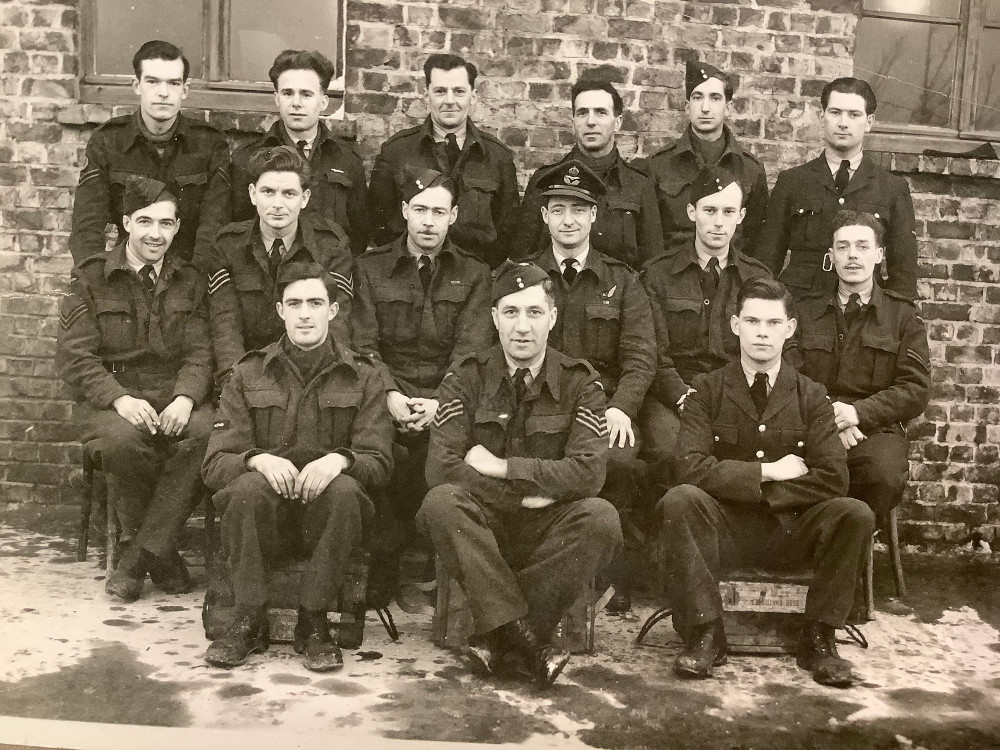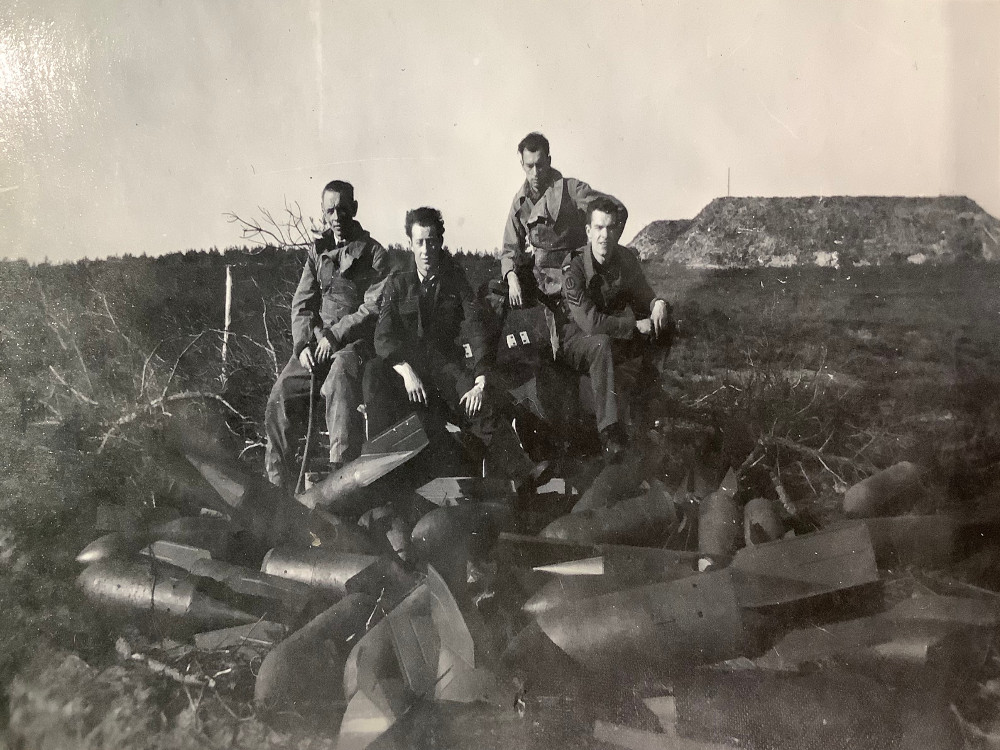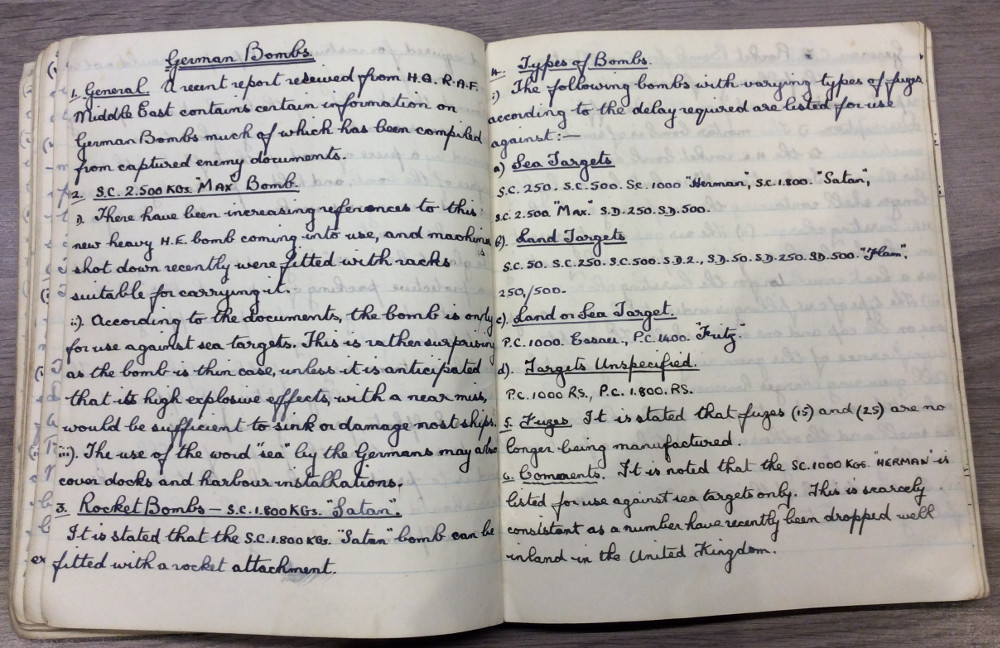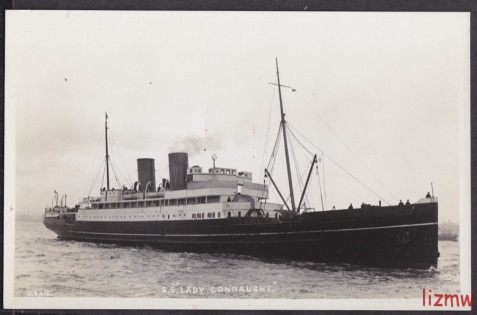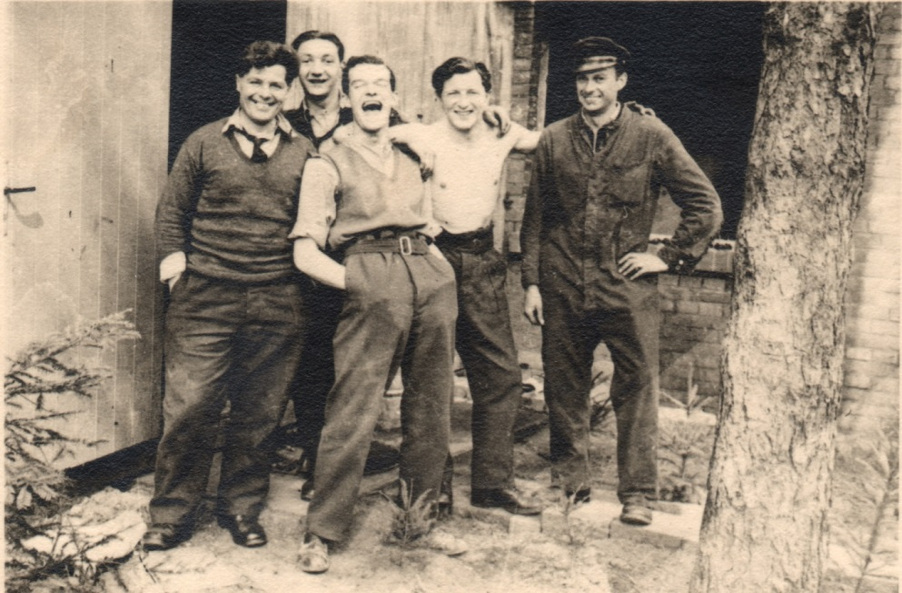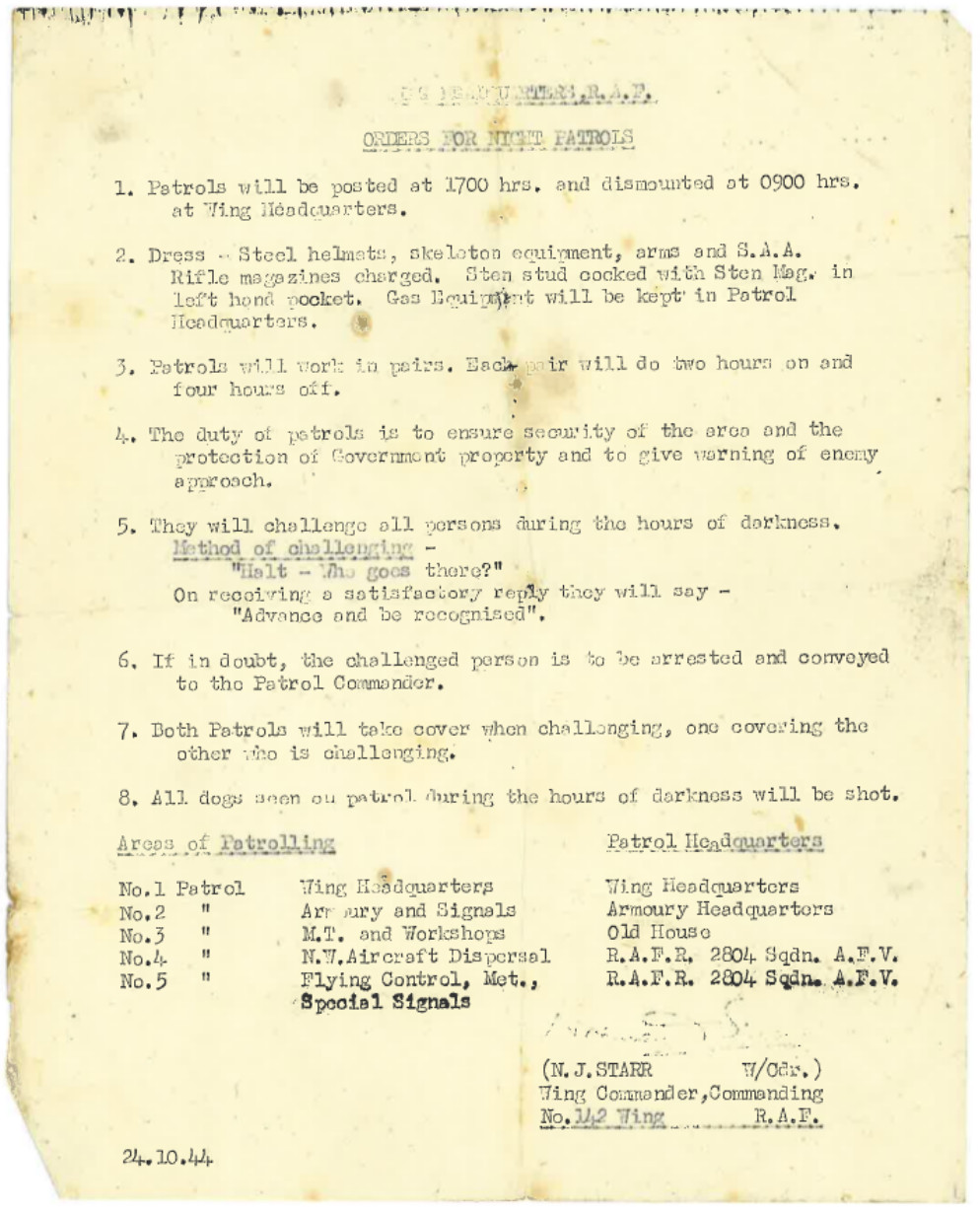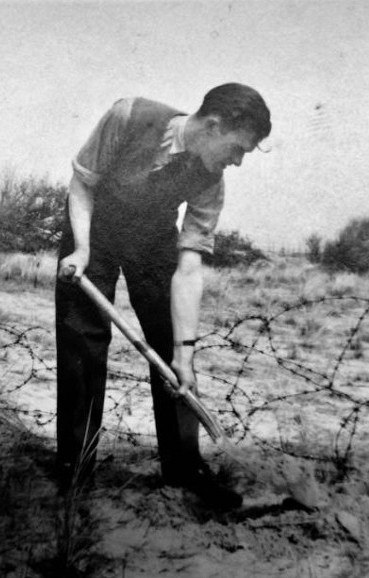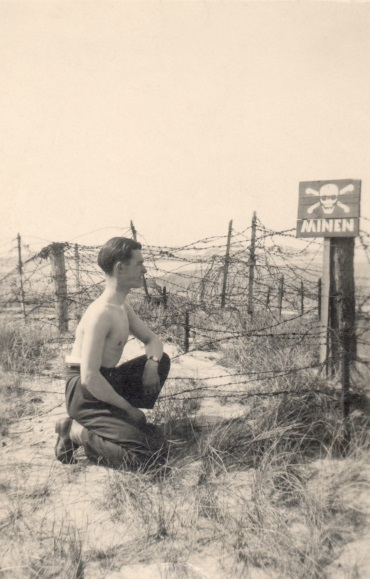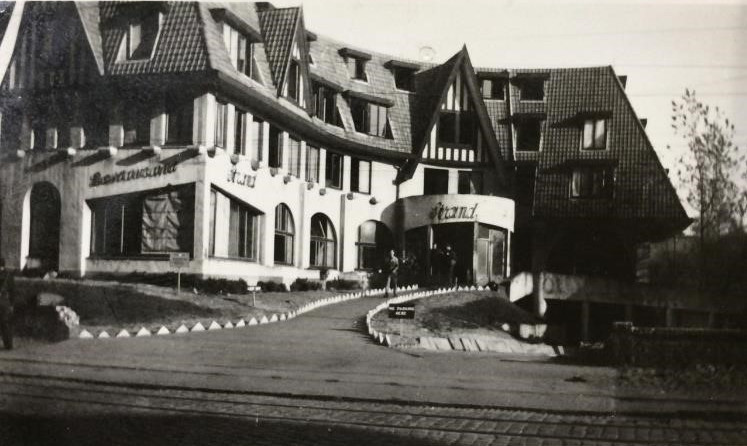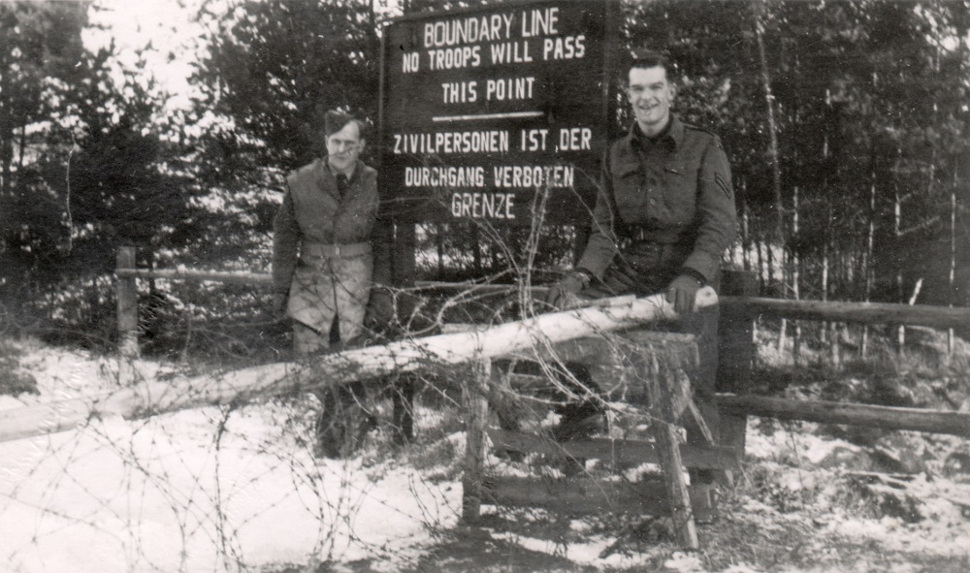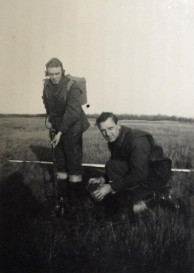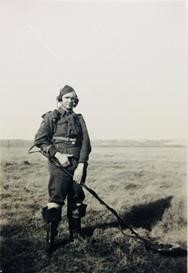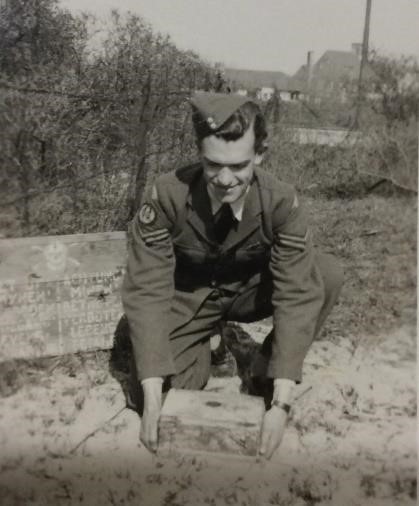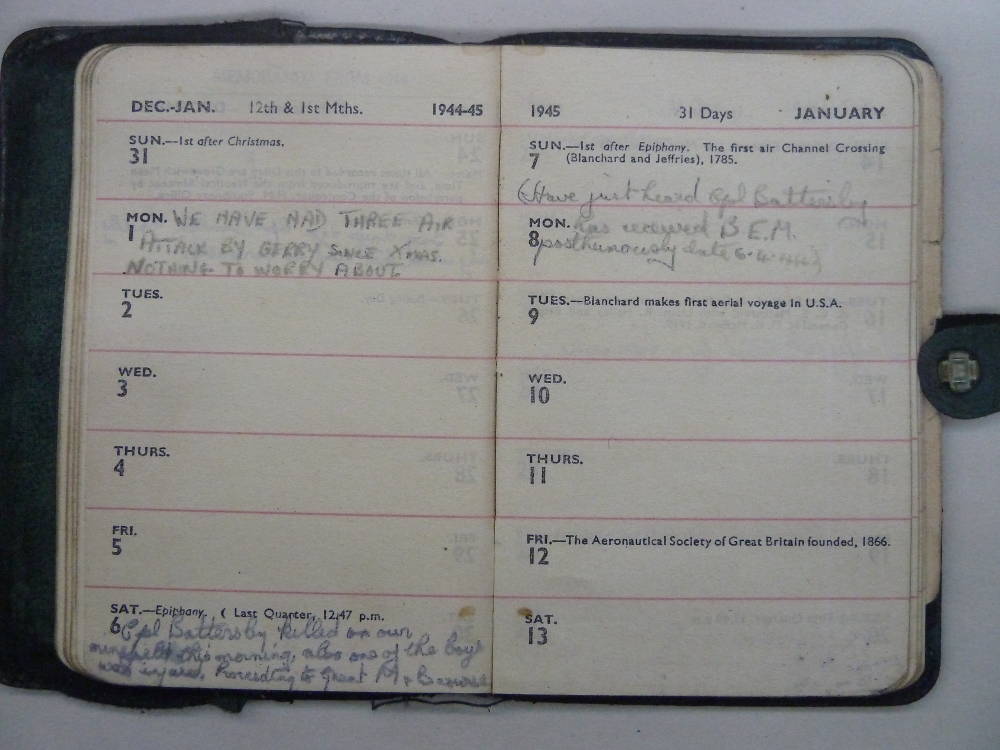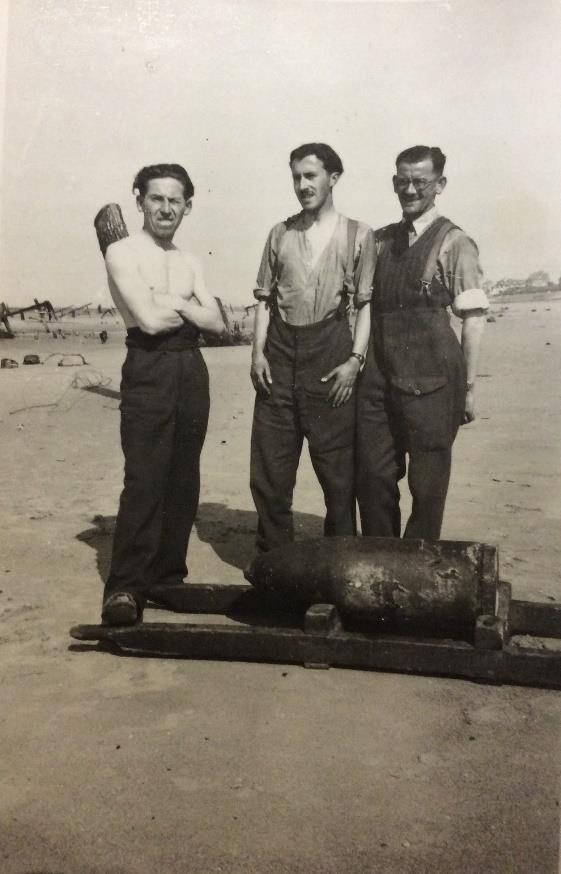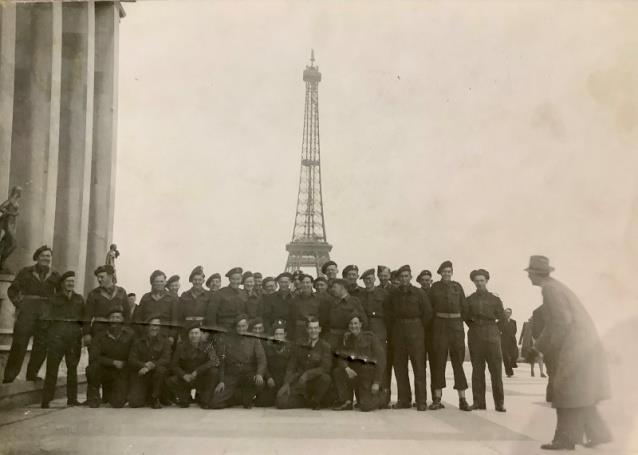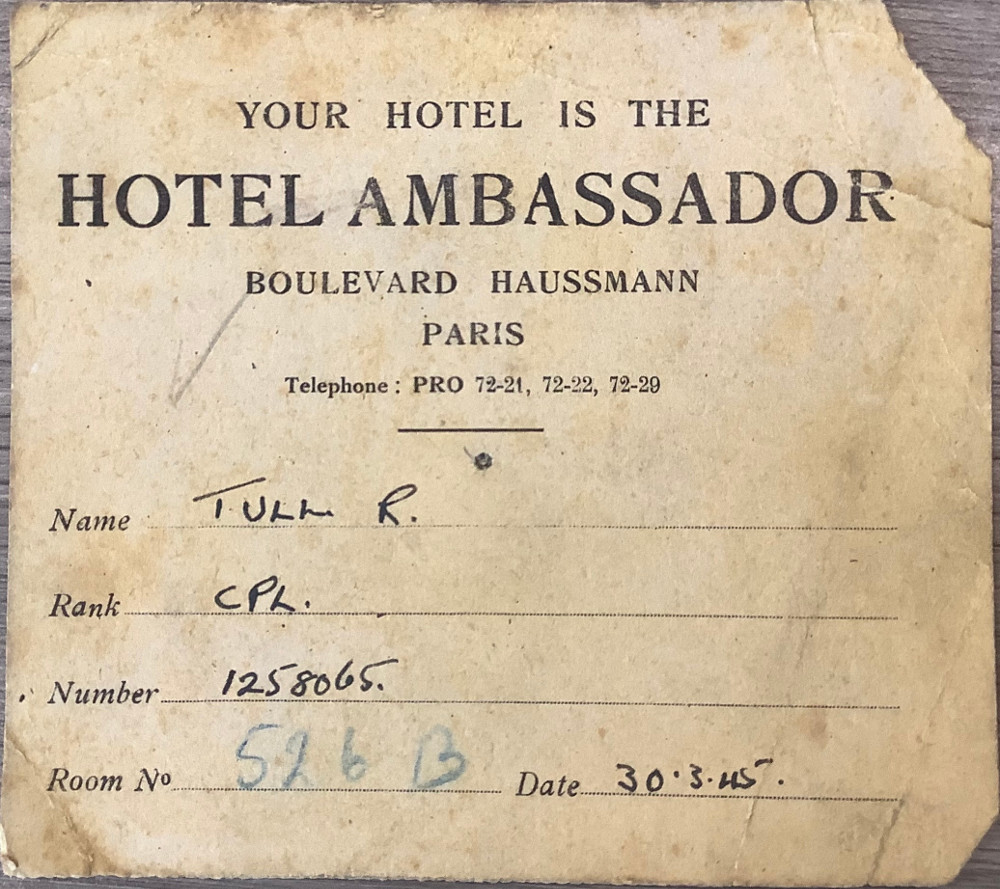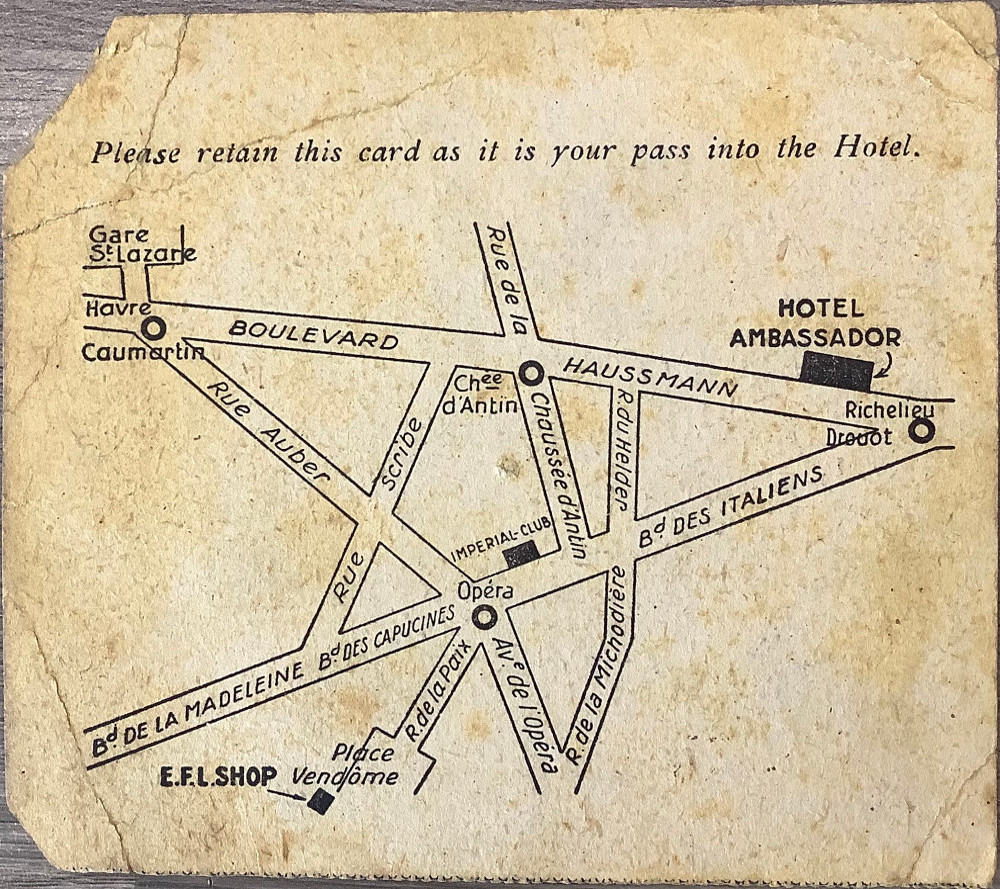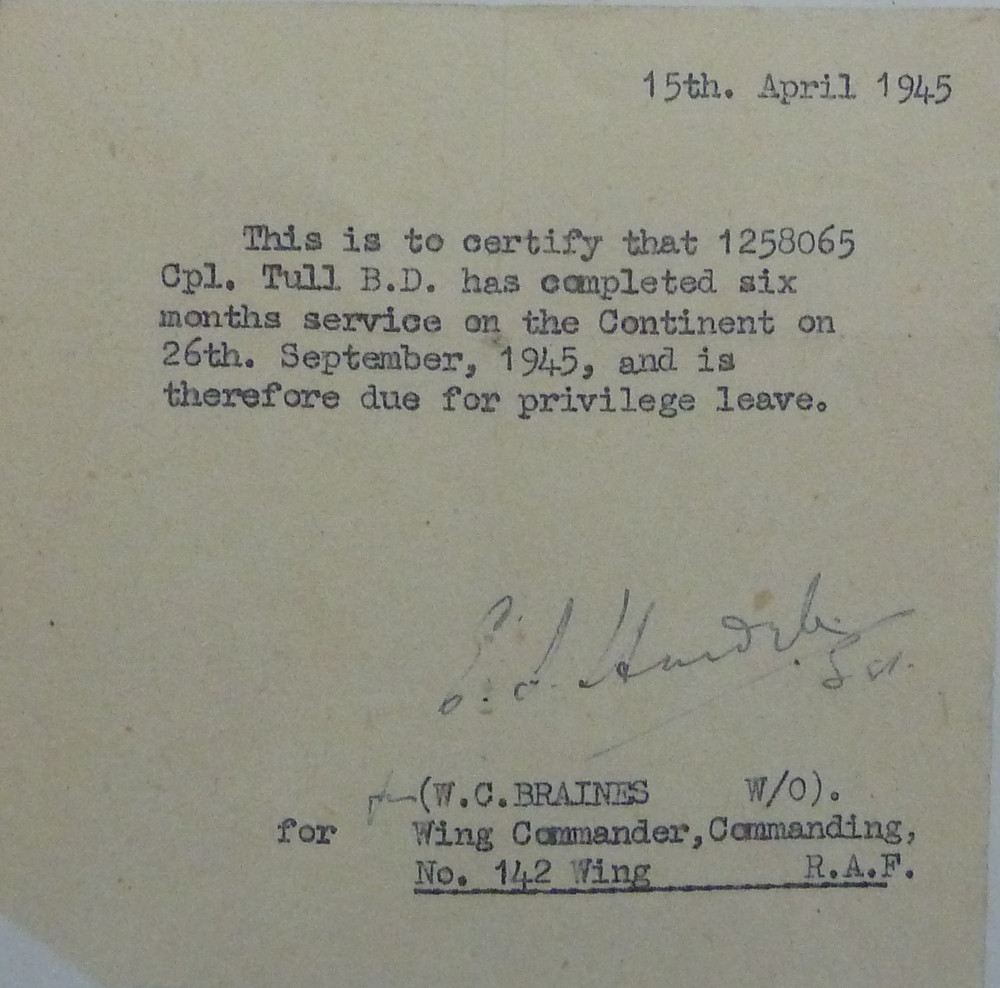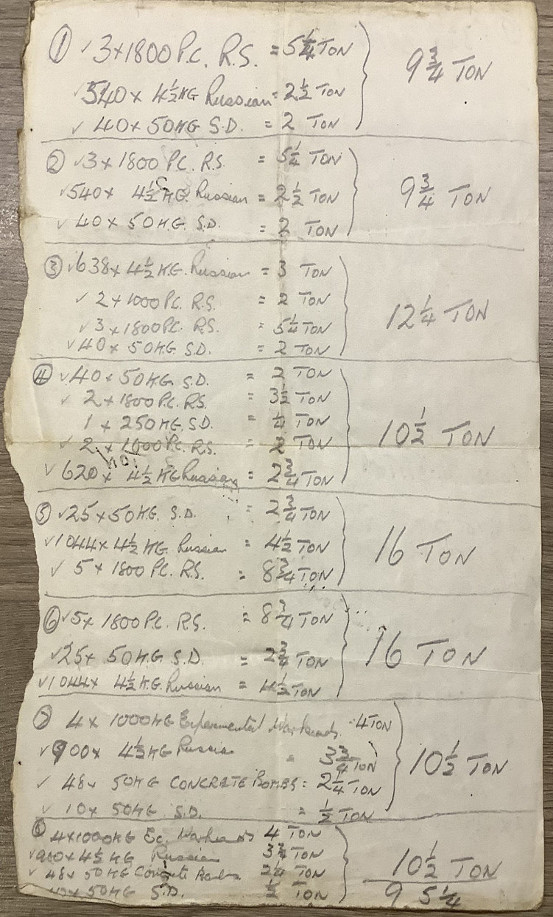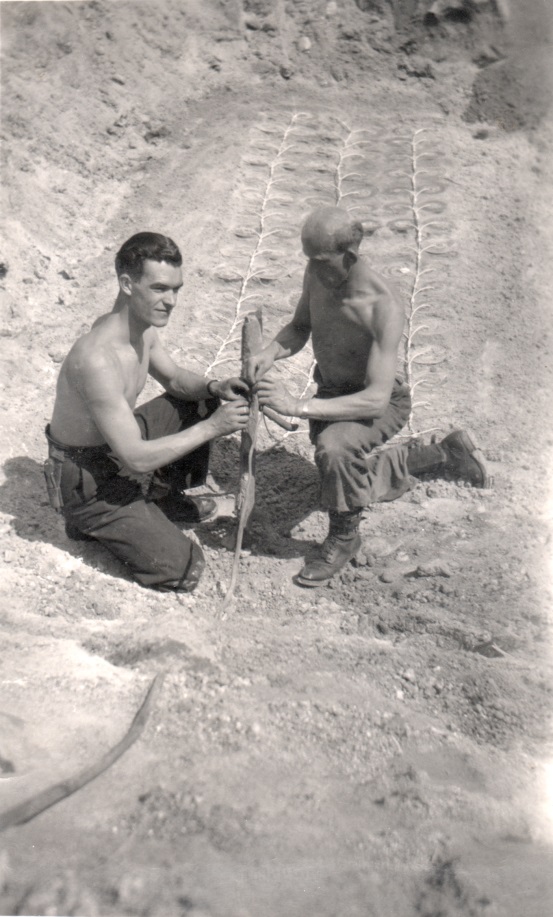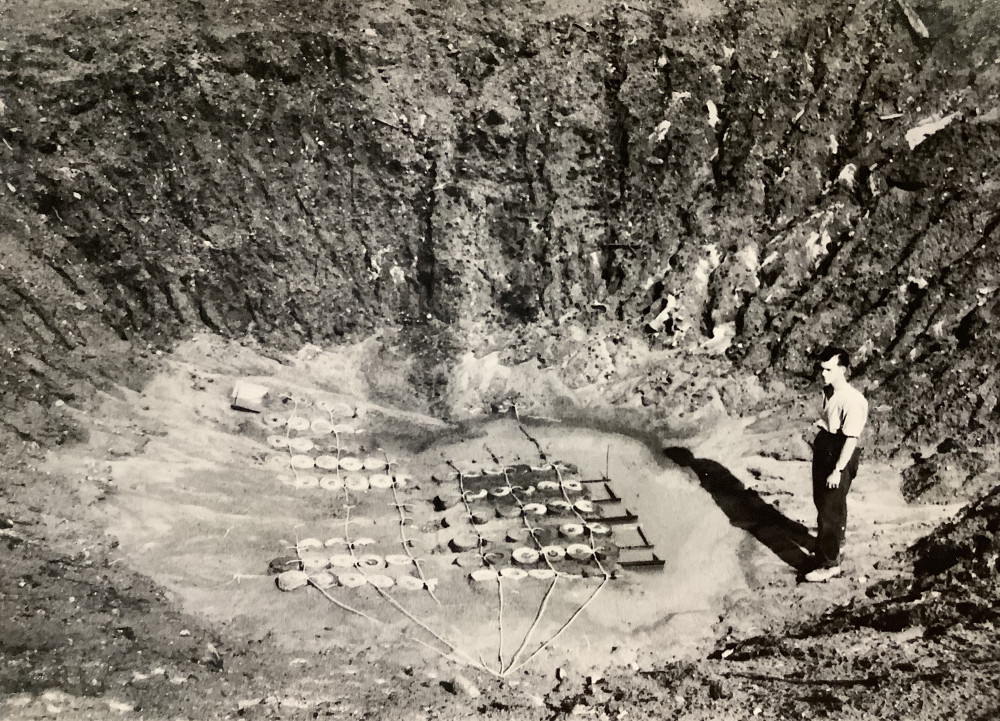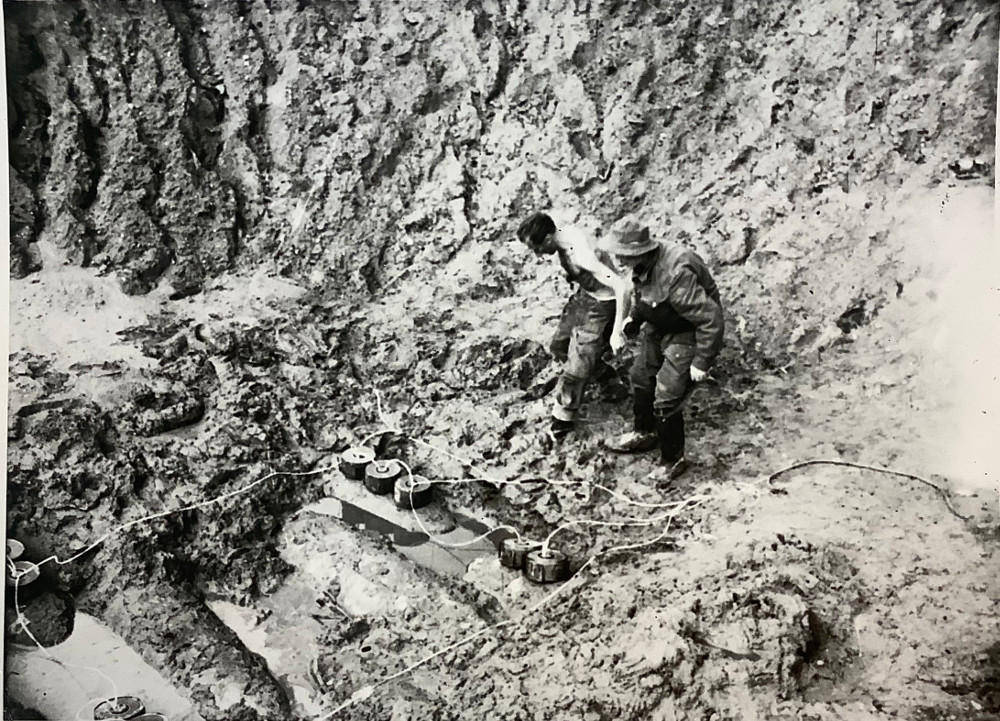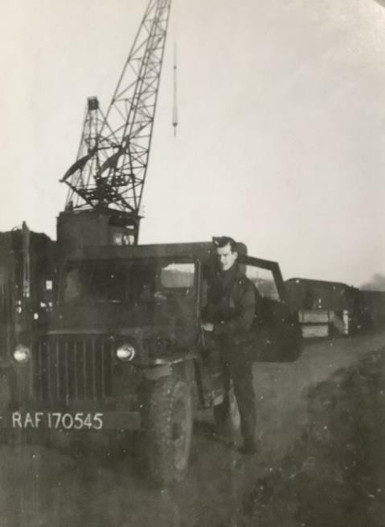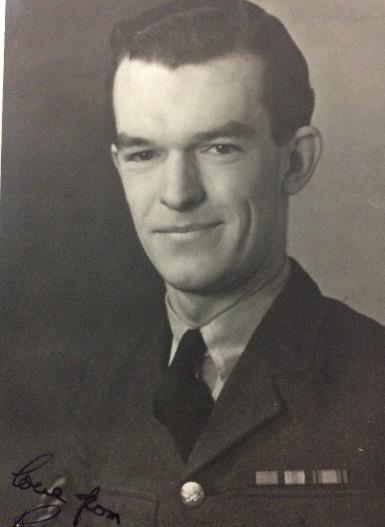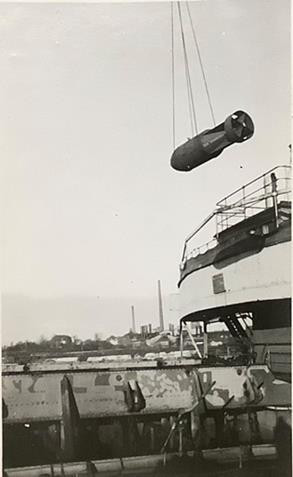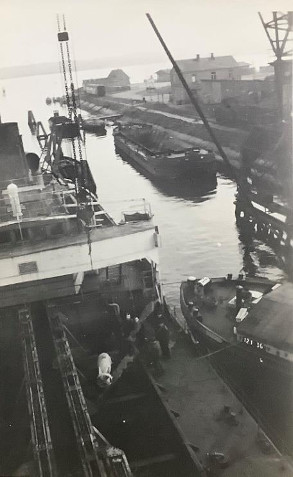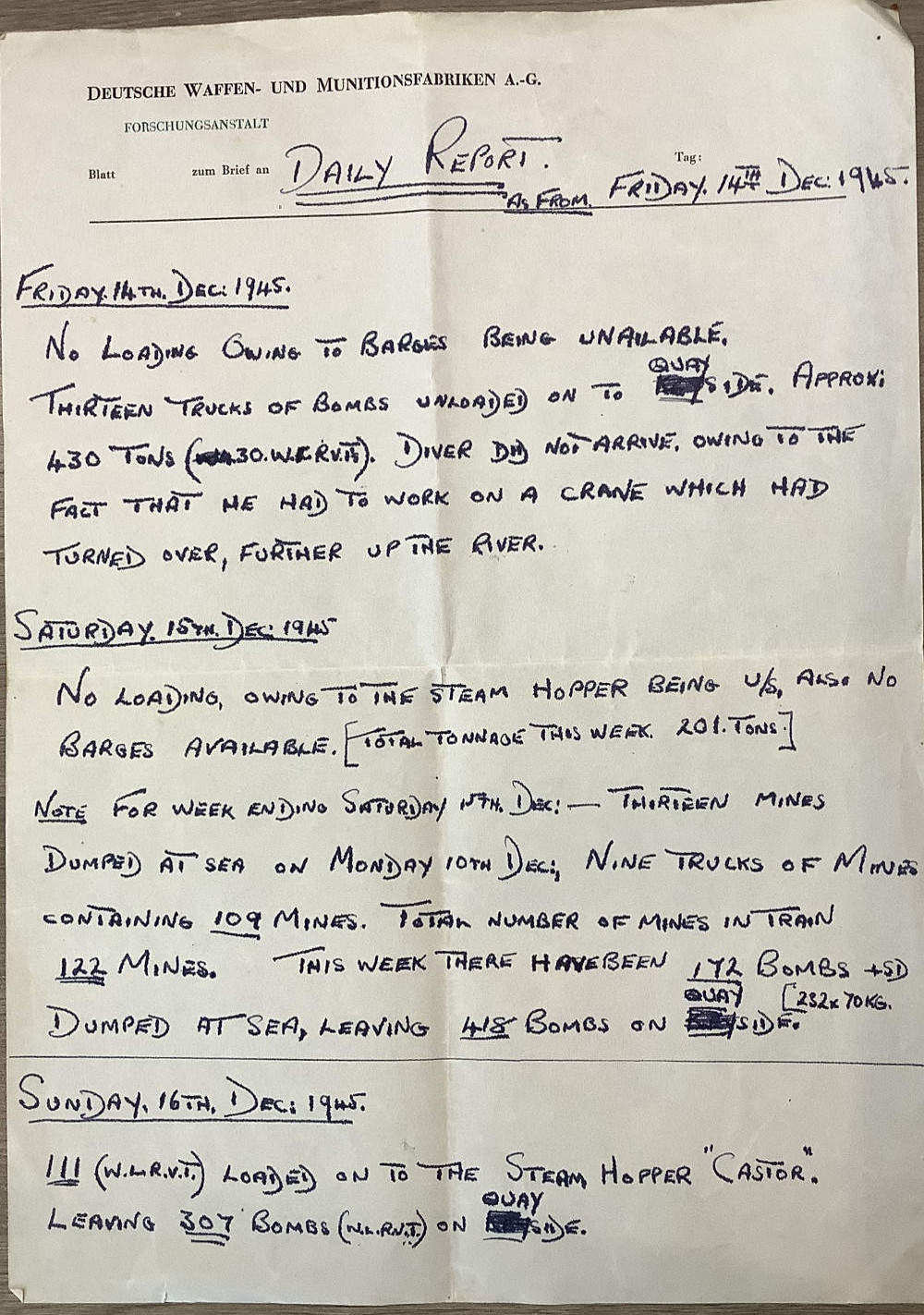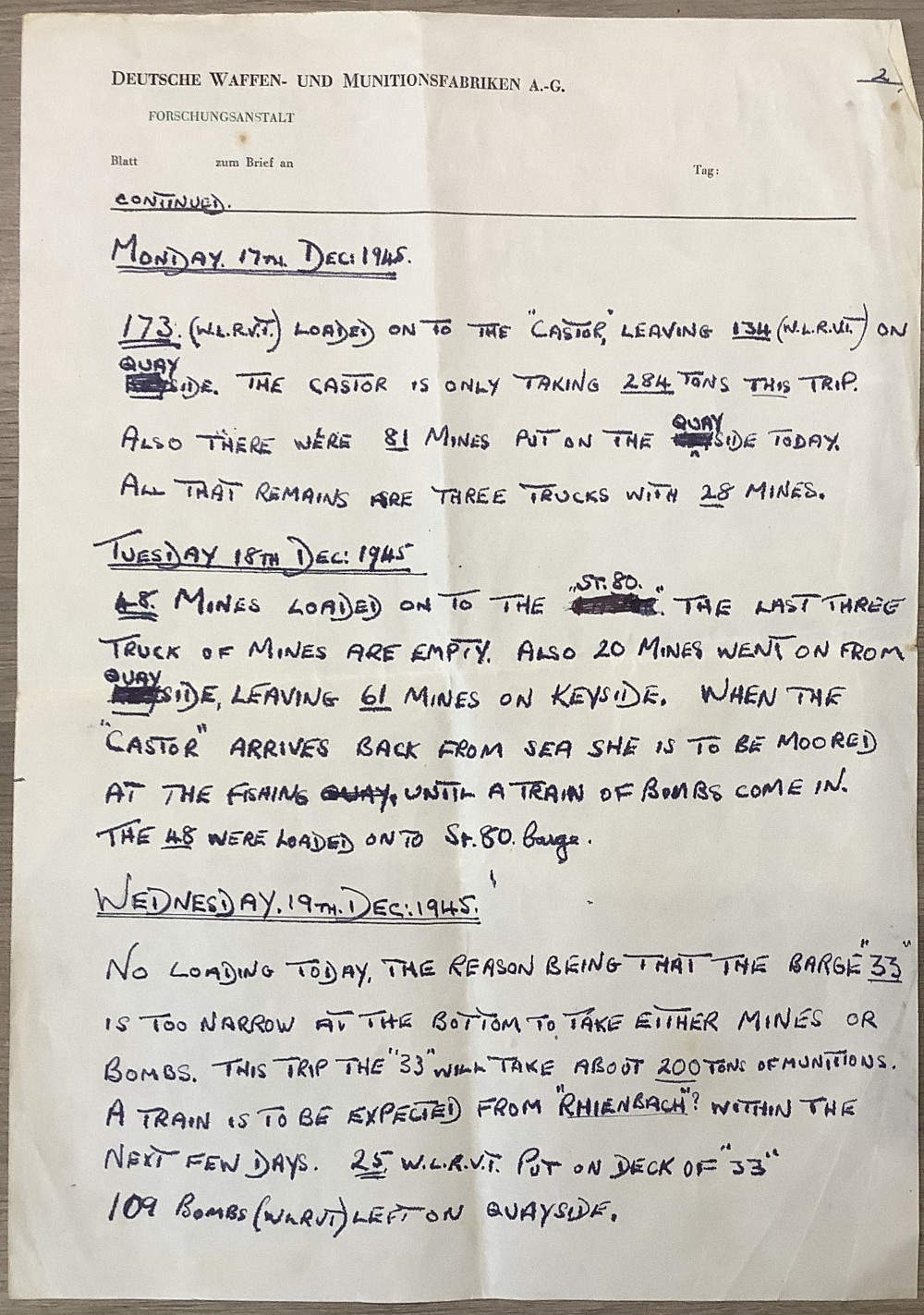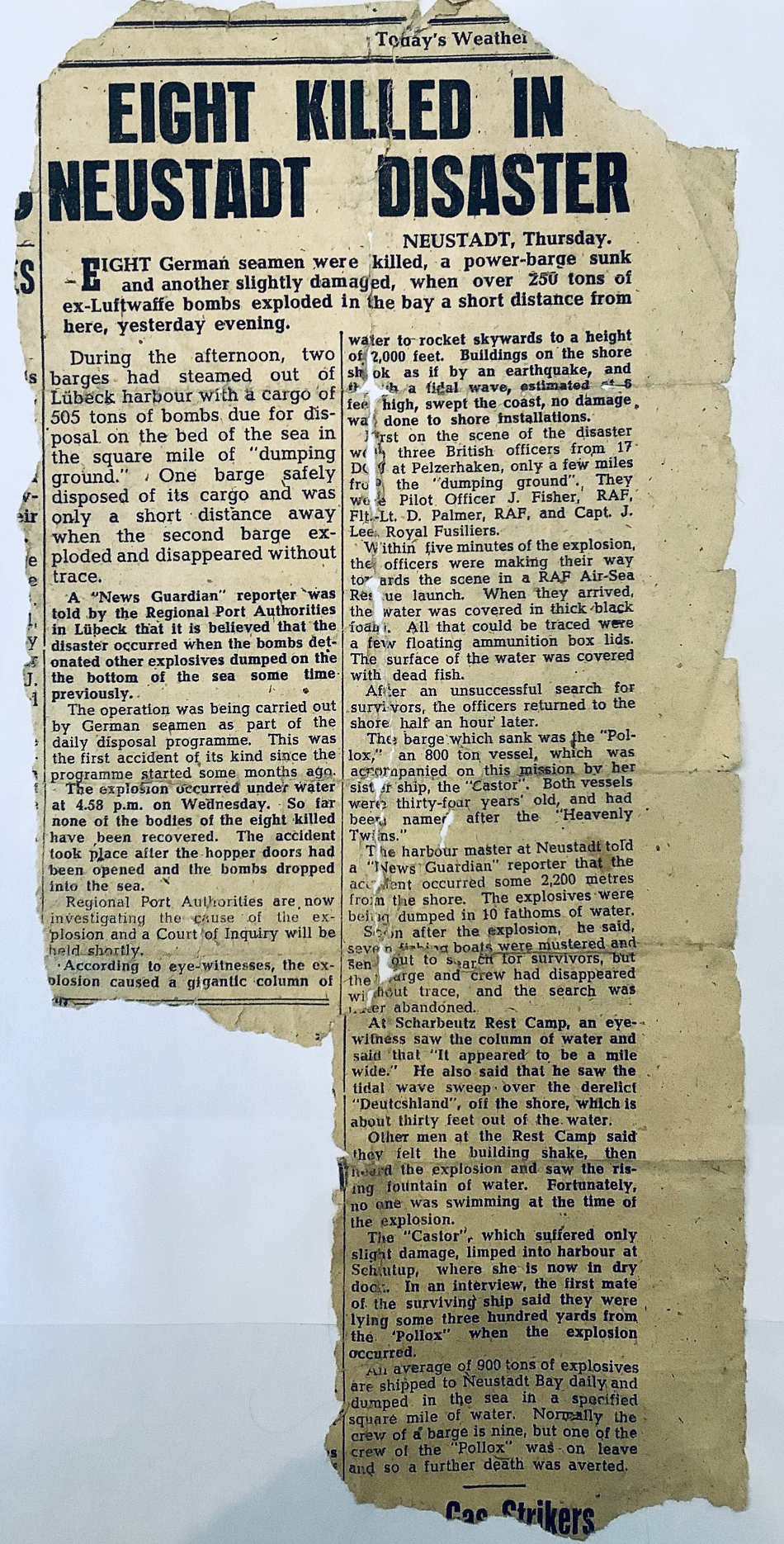Sergeant Roy Tull – 1258065 RAF Armourer/Bomb Disposal – 6210 Bomb Disposal Flight
Introduction In the month of May of the year 2019 TracesofWar published part of the contents of a diary on its website. That diary belonged in the Second World War to Sergeant Roy Tull, a member of a mine clearance unit - 6210 Bomb Disposal Flight - of the RAF. The data available at that time covered the period from September 1944 - January 1945.
We received the text of that publication from Mrs. Barbara Kelly, nee Tull, daughter of the aforementioned sergeant. After the publication of the article we were approached by Mr. Chris Randsted, archivist of the RAF Bomb Disposal Association. After both came into contact with each other, more information and materials about the service of Sergeant Roy Tull and his diary came forward.
Partly due to a mutual exchange of materials and after Barbara Kelly visited mainland Europe, where she was looking for further clarification about her father's experiences, she was able to compile a more extensive report of Roy Tull's diary data. Now we have data from 1940 to 1946. After this you can read the report she made.
19.7.40 RC Uxbridge. (Roy enlisted in the Royal Air Force, Volunteer Reserve.)
14.8.40 9 RC Blackpool (Recruits’ Centre)
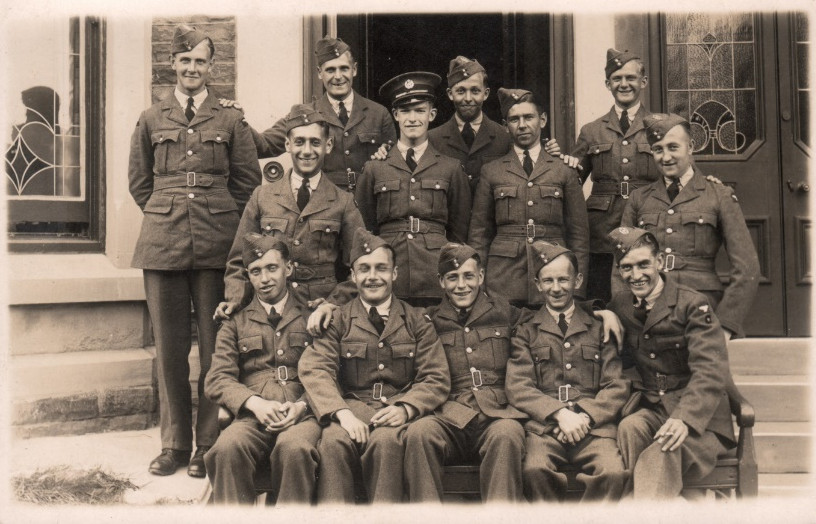
Soon after joining up at Blackpool. Did our square bashing there! 1940 Roy is on middle row, second from left. Source: Barbara Kelly
Roy was initially posted to Station Digby and wrote that, "I worked with unexploded munitions caused by enemy raids on our airfields and RAF property in Lincolnshire, Norfolk and Suffolk also on our own crashed aircraft, where there might have been unexploded bombs on board. For instance, on one particular occasion a stock of bombs was dropped, not all causing craters, this meant possibly camaflets were formed, where the bomb had exploded too deep to form a crater. I probed down the bomb’s entry hole and could find nothing, so followed procedure by placing small charge with a no. 11 safety fuse to release poisonous gasses from the camaflet. After lighting fuse I retired as quickly as possible to next crater for cover; just before I reached it there was a terrific explosion – there had been a bomb not a camaflet."
10.4.40 Stn Digby
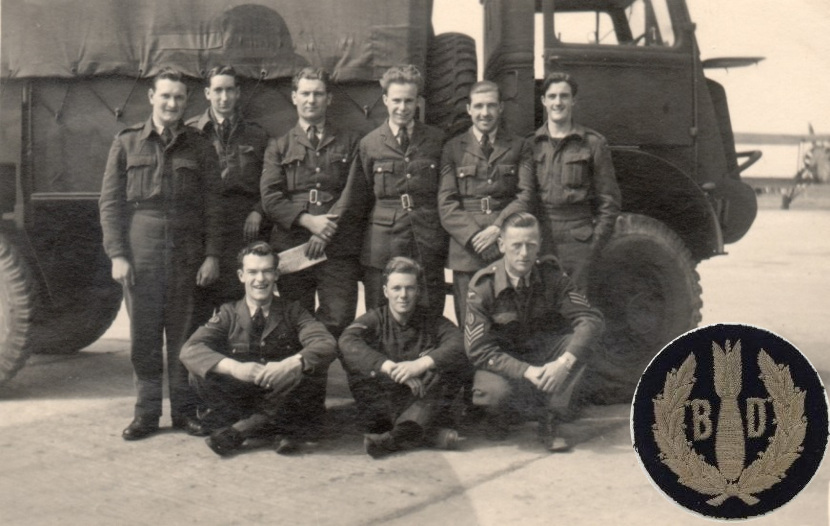
Roy ( seated on left) was attached to 6210 Bomb Disposal Flight.RAF Bomb Disposal Squad comprised: I officer of Flying Officer Rank - 1 Flight Sergeant Armourer - 2 Sergeant Armourers - 12 Corporal Armourers - 12 Ordinary Airmen (General Duties) for digging parties - 2 or 3 drivers (MT). Source: Barbara Kelly
30.4.41 25 Group. 12 Group Digby
21.5.42 25 Group. HO BD Wing
In addition to bomb disposal Roy also worked on arming Lancaster bombers.
23.6.42 10 S of TT (School of Technical Training)
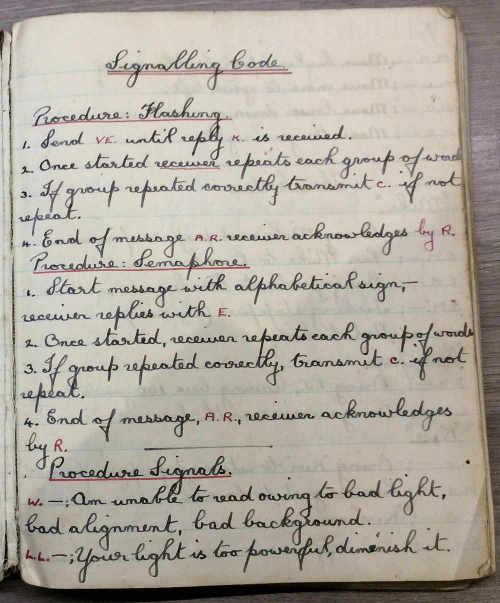
The Signalling Codes appear to have been used when working at distance from colleagues. Source: Barbara Kelly
18.6.44 BPSO (HS)
9.9.44 142 Wing
The following transcript is taken from a small, brown, leather bound, pocket notebook/diary which records Roy’s activities from the end of September 1944 up until the beginning of January 1945. Most of the entries were written in pencil. The photographs relating to the bomb disposal activities had been stored separate to the diary: where there are notes on the back relating the picture to a specific place these have been included. Diary entries from January 1945 are from a separate diary.
24.9.44 Sunday 24th - At transit camp At 09.45, arrived Southampton dock & board Lady Connaught (Liverpool/Dublin pre war boat)[1]. Left harbour just before one o’clock. Arrived Nap .. 4 o’clock. Left for France at 04:10 on 25.9.46. (should read 25.9.44)
25.9.44 Layed off Arromaches and boarded a tank landing craft, sea was very rough. Lorries took us to St Cromel de Freene … where we are staying the night, where from here I don’t know but boy oh boy am I tired!
27.9.44 Spent day just outside Caen. Breaking camp. Carpiquet 3 mls SE Caen. (Current day map shows an airport there.)
28.9.44 Route from Caen to Ghent: Caen, Lisieux, Thiberville, Boisney, Neubourg, Evreux, Pacy sur Eure, Vernon, Gisors, Beauvais, Breteuil, Moremil, Albert, Baupaune, Arras, Douai-Archies, Tournai, Leuze, Tuan, North Oudenaurde, Ghent (Main places). Stayed night in centre of Evreux. Went to a few cafes & had some wine, aperitif, cognac, Calvados & beer as we are sleeping in an open lorry – it has warmed me beautifully and I feel like ten men. We had lunch at 1.15 outside one of Lisieux churches – there are only the remains, but one could see they were once beautiful places. Hardly a house standing. People seem starved.
29.9.44 Left Evreux early this morning. We’re having lunch here at Beauvais where I am told the R101 crashed. There is a marvellous church here (it’s more like a cathedral).
30.9.44 Tues RENAIX (RONSE in Flemish) We crossed the Belgium border approx. 10 o’clock 30.9.44. Next big town was Tornai, one of the most beautiful places I’ve ever seen, a beautiful RC cathedral. At Camb…. Enormous flags from most windows and ‘Welcome to our Glorious Allies’ on quite a number of windows and everywhere once you get talking to the inhab (itants) thank us for liberating them. Note: I find my French extremely useful here in Belgium, more so in France. I have acted as an interpreter in several cafes/it’s great fun. I find I can understand their conversation but find difficulty in answering them. I’ve surprised myself, I didn’t think I knew so much French as I do.
1.10.44 Just settling down today, have moved from tents to a large shed with practically no windows and also terribly cold at night (I’ve only 3 blankets). I have a German bed to sleep on, an iron effort. I have no mattress, and one could play noughts and crosses on my back every morning.
2 – 7.10.44 Working hard between these dates but nothing of any importance to relate, except went down to Ghent looking for present for Cecil, Winnie, Gordon, Hugh & Edith, Rita and of course Fred. Write a letter to Fred. (TF Charlton, father)
8.10.44 Wrote to Dorothy Armstrong. Nitchfield.
11.10.44 Holland. Wrote to Rita Arrnnemberg. 12 Salsberg, Oostenburg, Mausi.
12.10.44 Wrote to Betty. Heard today that I am on the advance party to front line 3 ½ to 4 miles north of Brugges, maybe a rumour, we will see anyway on 14.10.44. Heard plenty of work to do up there.
16.10.44[2] We have arrived at our destination three miles north of Brugge, the Bosche is said to be in a chateau across the canal (we are now in the Canadian beachhead). We expect to have a sleepless night, gun fire is terrific.
Have noticed the construction of all Belgium bridges this way, they are really beautiful jobs. Just heard Bosche 3 klm from here. Officer just said if we want something to do, go along the road and help the RAF regiment out there having a go.
Cont. Last Jerry patrol captured here five days ago. As we passed through Brugges the people thought we were prisoners (Bosche) because of our dusty blue battledress, this is by no means the first time we were taken for Germans, happened in Ghent and many places.
We left Ghent ((Denise St Westrem / St.-Denijs-Westrem in Flemish) at lunch time. King George visited our air-strip, sorry I missed him. Went into Brugges, it was dusk. We couldn’t see the sights but two lovely girls took my pal and I in tow. Went home with them & had some beer. Unfortunately, the curfew is at nine so we left early.
17.10.44 Settled in chateau.
18.10.44 Bought a 2.2 revolver off a squaddie, might come in useful sometime. Bought in Brugges.
19.10.44 We have been settling in today on the airstrip, moved into civvy house with my pal Ernest Philips, sleeping on divan in a bedroom. An enormous change, too good to last. I hear we are pushing the huns out of the pocket next week. The Canadians have {already gone. The bombs for the storage arrived today, we reached the far edge of Bruges. Fighters are arriving soon.} We have guns on strafe which makes a dickens of a noise day & night. Jerry is only 3 ½ – 4 km away. Much too near for comfort. He keeps sending patrols over.
The gunners told me this morning they have allowed civvies to pull the lanyard to fire the gun, the gunners said we may anytime we like, I’m looking forward to firing the gun (one has to wear cotton wool in one’s ears). The shells weigh 20…………………………………………………
Army have had reinforcements parachute …… They have many Tiger Tanks …. …… They sent a patrol over the canal in a hewn out log. Canadians killed the lot, except one, who escaped. The billet is very good, teacher & his wife & 3 girls.
22.10.4 Part of a hun patrol were caught on the airstrip last night by the guards. …… shot on strip this afternoon. We have been ordered to carry our guns everywhere we go. There are many rumours, too many to write down. Moved into another house, the late owner was very ……. ……….. ……… He is now awaiting trial (collaborator).
26.10.44 One of our cookhouse chaps went into Brugges the other night, has not returned, believed murdered by collaborators, have been dredging the canal.
27 – 2nd Nov.44 Nothing much to relate between these dates except that fifteen Huns escaped while passing through Brugges. The cook, Salt, was found in canal with his head smashed in at the same time as Tommy was found with his throat cut.
2.11.44 Wireless says fighting ceased in this pocket at 7.30. Guns were still blazing away late in the day. Gerry got within 1 ½ - 2 miles from our airstrip, the Canadians had cut the pocket in half and were forcing them this way. Guards doubled. I was a guard commander the other night, second time within twelve days. Plenty of prisoners passed through yesterday. I hear leave has started in 83 Group (Brussels not Blighty).
4.11.44[3] A V1 passed overhead tonight going in the direction of Courtrai.
5.11.44 Knocke. Gerry was here Friday 4.11.44. The whole airfield is mined, so expect loads of work in the very near future[4]. We have had rather an exciting day. Left Brugges 2 o’clock, arrived Knocke drome about 5.45 hrs. The whole drome is heavily mined, all sorts of munitions here. There are about 25 of us in the advance party. I am the only BD Cpl with party at the moment.
*Read also: RAF Bomb Clearance & Demining at Knokke Airfield*I am writing this from a room in the best hotel in Knocke, this is a single bedroom with a lovely old bed, wardrobe, wash bowl, there’s no electricity or water. There is a board on my bedroom door ‘Brigade Major’, best room I have had since I’ve been over here.
Mines in the road on the way here are painted white, the poor driver had to dodge these. All the Canadians left this morning, we 25 are the only military in town in charge of the town. I guess there are 11,000 prisoners said to be roundabout town. As I have said Gerry was here in force the day before yesterday. We crossed the border into Holland. 500 collaborators (men) yesterday. Are collecting the women today.
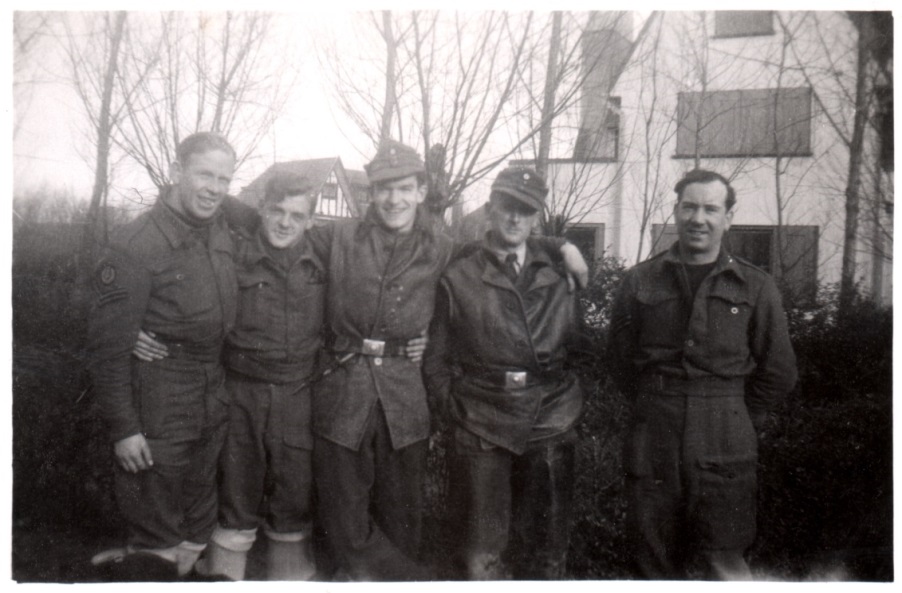
Photo labelled – "With some mates in our unit - outside our hotel in Knokke, 6th Nov, 1944" Source: Barbara Kelly
8.11.44 I don’t think I’ve mentioned anything about the floods around here (Hun did it I believe). Went back to Brugges yesterday, the road was flooded in many places, we couldn’t see any sign of road or verge[5]. Mine notices very nearly all the way to Brugges on either side of road. Most of the villages are uninhabitable, all houses that aren’t down have shell holes through the roof and walls. Goodness knows where the people sleep or where they get their food, the villages are even worse than Caen, Liseux or any town I have yet seen. There are literally hundreds of dead cattle and horses in the fields for miles around, one can see them floating in the flooded fields, or with head blown off, a horrid sight altogether.
Going to Brugges yesterday means I have been in Holland twice now. OK! By the way, there is only one café open in the whole of Knocke.
6 times into Holland.
11.11.44 We have been very busy last few days. Have been to Brugges again (3 days ago) for rations. In the three or four days 13 chaps have been blown up by mines and booby traps. Three or four of our BD chaps coming to work with us on the minefield got blown up before they reached us, the driver Cpl Talbot got killed and the others injured, they went along the wrong road. When I think of the way we came to Knocke (we took the wrong road) I break out in cold perspiration.
Tomorrow I start on demining the airfield, it does nothing but rain here, and the wind oh! la la. This morning two cpls (myself included), 9 men, 1 sergeant and 1 officer made up a RAF contingent for attending the laying of wreaths on the 1914-18 war memorial. What a ceremony, we paraded at eight o’clock and marched to the church. Incidentally, it was the first RC church I had been in over here, all the chairs are back to front – they have a long back with the seat about 1’ 6" – 2’ off the ground. The whole of Knocke must have been in and around the church, there were the White Army[6], police, girl guides, scouts, nurses? + loads of men wearing uniforms. I’ve never seen lots of banners ………Army contingent of 1 dozen men. After the service we tried to march to the war memorial, and there the mayor made a speech. People afterwards sang all the national anthems, and when they came to their own they put their hearts and souls into the words. Tomorrow Knocke are having a liberation dance – I hope I can get to it.
13.11.44
I forgot to relate that following that week a troop IE outside Ostend harbour went down in one minute and a half – 300 RAF fellows gone ………………. many in ……………the whole ………. Out of the …. away. They were informants I guess, it is said a plane was heard overhead before the explosion.
It was terrible on the minefield today, frightful wind, rain all day. We are probing every inch on our strip, probing for wooden box mines, Horse mines also, the mine detectors will not pick these up. Am terribly tired tonight. Am trying to write to Alice, Hugh and Betty.
22.11.44
Since the last entry I have been demining. Total up to date for the field is 2,658 mines, Teller, Shu, Halz & S mines. OIOBD … beginning to take interest – this is the biggest job ever undertaken by BD. 3 more Res got ‘done up’ today de-lousing hotels – total now 13.
25.12.44
Two days ago Cpl Denton badly injured, two not so seriously. We had a raid today, machine guns and bombs on the runway, not a lot of damage.
26.12.44
Many things have happened since I last made an entry. We have picked up 14,000 mines of all types. By rights I should be dead now (3 times, it has happened) if the mine had operated, but luckily for me it did not blow up. The RE’s (Army Royal Engineers) here have had 40 casualties. We haven’t had any, although two men of the wing have been injured. One picked up a booby trapped revolver and the other operated a loaded bazooka, both badly injured. We have had Gerry para landed near here, some have been caught but it is believed many are being housed by collaborators. The whole of Knocke is absolutely full of collaborators. I’ve seen loads of them, I’ve been with the lads of the White Army and they have pointed them out to me.
We have to carry loaded guns at night. Jerry bombed us last night, managed to get two hits on runway, not a lot of damage.
31.12.44
‘S’ mine blew up on the minefield (Hildeguard), badly injured two of our chaps and injured another not quite so badly. I took one to the sick bay. He was too dazed & numb to feel his injuries, one being half his nose cut off. I’m afraid this made me a little shaky for the rest of the day. It is things like this that upset my nerves for a while but I soon get over it.
1.1.45 We had some Messerschmitts over at breakfast time on recco. I guess also 12 Mess, about a quarter to ten, they machine gunned us on the drome, but ak managed to knock down two and another probable. We have had three air attack by Gerry since Xmas. Nothing to worry about.
6.1.45 5139 (BD) Sqdn (17) Cpl Battersby killed on our minefield this morning also one of the boys was injured. Proceeding to Ghent M & Be ….
.7.1.45 (Have just heard Cpl Battersby has received B.E.M. posthumously date 6.4.44)
11.1.45 142 Wing
16.1.45 Taffy (Cpl) killed by a box mine.
15.2.45 German captain caught in civilian clothes by a chap of the White Brigade.
26.2.45 Big wing check up for deserters. All confined to Barracks. 5 Gerrys caught in khaki.
5.3.45 A Gerry from a one man sub was picked up by one of four Walruses. On alighting from the plane he thanked and shook hands with the pilot and gave some important information, ie there were 50 subs at the base he had just left. (Afterwards the chap proved he was a clerk and like many more Huns browned off with the war.)
10.3.45 A one man sub beached here. The Hun alighted and held up the astonished civils with his luger.
11.3.45 11 boats including subs sunk by our Sqdn in the last few days.
12.3.45 An Anson sighted a one man sub. The one man crew jumped overboard and the sub was seen to overturn and sink. The Anson dropped a dinghy for the Hun. He was picked up by one of our Walruses two days later. Incidentally the Anson didn’t or doesn’t carry bombs or guns.
16.3.45 Have heard I might be on leave at the end of April. Hope it is true.
28.3.45 Have just heard going on leave May 30 th . Hope nothing happens to cancel it.
29.3.45 Proceeded on 48 hours to Paris .
30.3.45 Went to the evening’s performance of the Folies Bergère. It was really worth the admin fee of 125F.
31.3.45 Went to the Casino de Paris. Rather vulgar, not as good as Folies.
2.4.45 Arrived in Brussels from Paris about 8:30hrs. Heard that Rundstedt was in Brussels. Here is another rumour – Goering has committed suicide and Hitler has been assassinated.
9.4.45 I heard this afternoon that I’m being posted to a Field Force Flight. Sq/L Scammell was down here yesterday and told Sgt James. Hope it doesn’t come through until after my leave.
16.4.45 6210 Flight
27.6.45 142 Wing
1.5.45 Left St Petre’s Station, Ghent for Calais. Arrived Calais 3.30.
2.5.45 Arrived home on leave, docked at Folkestone approx.: 2.30am.
16.6.45 F/LT Booth and CPL Tull visited Hesedorf and inspected GAF ammunition store houses there. ‘Starkshorn Demolition Dump. Germany May 1945’
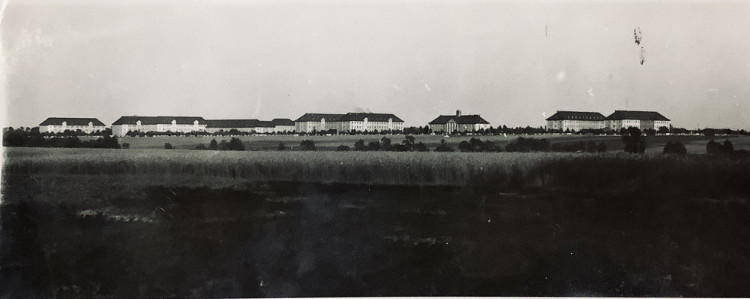
Roy Tull appears to have been living at the RAF Trenchard Baracks, Celle, NW Germany, when he was working at the Starkhorn demolition dump from May 1945 Source: Barbara Kelly
18.8.45 (September) Proceed on leave to UK. It cannot come soon enough. I hear we are having an extra two days (in honour of VJ).
19.8.45 Hamburg (half day)
21.8.45 Left Stade for 5140 BD Sqdn, 84 Group HQ Celle (near Belsen). Only four of us in the advance party.
25.8.45 Left Celle at 10:20 hours, arrived Stade 12:35 hrs. Spent half day in Hamburg.
26.8.45 Am in Hamburg, time 16:15 hours, drinking (lemonade) in café. Probably the last time I come here.
27.8.45 Tomorrow at 06.30 hrs I leave for Celle, taking with us Sgt Canary ‘B’ Class demob. Lucky chap will be home for good in few days.
8.9.45 Admitted to 54 MFH (Mobile Field Hospital)
18.9.45 Made wrong entry for my leave (Aug: 18th) Today Sept: 18th is the day.
24.9.45 Transferred 8 RAF Gen. Hosp. (Rinteln)
28.9.45 Discharged 8 RAF Gen. Hosp. (Rinteln)
16.10.45 The Day has arrived at last, leave to the UK (Twelve days at home this time).
17.11.45 37.E.A.D.C.C. (A) Proceeded to Stade – in the afternoon went to Hamburg left Celle about 9:30.
18.11.45 Went into Hamburg at 2 o’clock, left at ten o’clock.
24.11.45 Fraulein Anneliese Gabrisch, Hamburg 39, Surichstr. 57/25 25 32
27.11.45 The Steamer "LIBAU" is going away for good today. It’s going to be used by the Russians.
14.12.45 Sgt Wing has gone back to H.Q. leaving me in charge of job.
15.12.45 Hitch hiked to Hamburg. Arrived there 15.45am. Frightful day, terribly wet.
16.12.45 Left Hamburg 5 o’clock arrived in Lubeck about 7 o’clock, had three different lifts. Had dinner in the White Knight and went next door (Garrison Theatre) and saw an impromptu variety show, it wasn’t too bad. This week there’s Ivy Benson and her Band (Happy Memories).
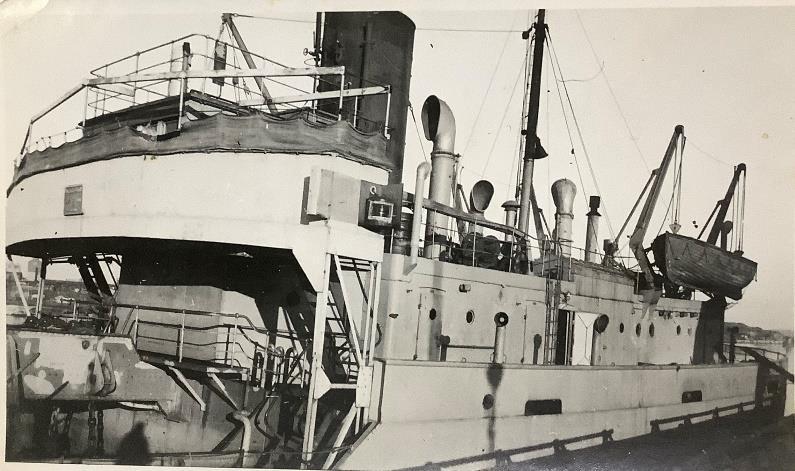
Castro arrived, sister ship to Pollak. I think this was the ship, Pollak, which was blown to smithereens, nothing found of her off Lubeck. Source: Barbara Kelly
(A news article from that period found in Roy’s wallet stated that over 250 tons of ex-Luftwaffe bombs had exploded at sea, off Lubeck, killing 8 people. It would appear that it also ignited munitions already dumped on the sea bed that, according to one witness, caused an explosion almost a mile wide.)
23.1.46 6210 FLT
8.3.46 135 Wing
12. 3.46 6210 FLT>
17.11.46 Class A Release – "A young man of happy disposition who is a reliable and hard worker. Has done some good jobs of work on Bomb Disposal & proved himself very able as an artisan & an administrator."
2020 Barbara Kelly wrote:
Roy returned safely from Europe at the end of 1946 and was briefly in Cornwall, farming. He married a local girl, Enid Chin and then trained and worked as a residential child care officer, carrying out some of his training in London at a Jewish home for children who had been rescued from German concentration Camps. Roy and Enid ran children’s homes for many years, had two children of their own and finally retired to a little seaside village in Cornwall. Roy was one of life’s true gentlemen, unfailingly polite and self effacing, always kind and considerate, and a loving husband, father, grandfather, brother and friend. He died on the 15th January, 2003 and was sorely missed by all who knew him.
* Read also: RAF Bomb Clearance & Demining at Knokke Airfield. *
Notes
- Lady Leinster was retained as the third ship on the Liverpool-Dublin route, but was confusingly renamed Lady Connaught (second), the original Heroic having been the Lady Connaught (first) from 1930-1939. In January 1944, the Lady Connaught went to Barclay, Curle's yard in Glasgow for extensive reconstruction as a hospital ship, which included the loss of her dummy funnel. Lady Connaught (second) attended the Normandy beaches after D-Day and would lie off the beaches taking on wounded. Once full, she would head to Southampton, unload within several hours, and then return to the beaches. Her medical and nursing staff were all American. She continued this work until June 1945, when she returned to Belfast to be laid up whilst her future was considered.
- The Canadians launched final attack on Woensdrecht today with immense artillery barrage. (Barbara Kelly)
- Historical note: On 3.11.44 Knokke was liberated by the Canadians on this day. The Germans had fled to the Netherlands. The Canadians had to ‘clean’ the beach, because there were a lot of German mine fields and fortifications.(Barbara Kelly)
- Airfield Knokke-'t Zwin (also known as Knokke-Le Zoute or ALG B-83). In the middle of October (1944) the area was liberated by the Canadian Army. British engineers tasked with repairing the site reported in late November: "Repair of the airfield (B83) has begun by filling the trenches and demining. Demining task is enormous, as 5000 mines have been found to date." It was reported that in total the British engineers found 12.000 mines at the site.
- In early October, Allied forces led by the Canadian 1st Army set out to bring the port of Antwerp under control. But the well-established German defenders staged an effective delaying action. During which time the Germans flooded the Scheldt Estuary which slowed the Allied advance – this may be the cause of the flooding Roy is writing about.
- Belgium resistance fighters
Definitielijst
- bazooka
- American antitank rocket launcher weapon. Rocket with shaped charge is put in a long tube which is electrically fired from the shoulder of an infantry man. The bazooka can be reloaded. The bazooka produces a large flame to the rear which makes it unsuitable for fighting from closed compartments or from homes. British counterpart is the PIAT, Projector Infantry, Anti- Tank, also a man-portable anti-tank weapon. Germany used Panzerfaust and Panzerschreck, “armour fist “ and “armour terror”.
- billet
- To lodge soldiers in a particular place, especially a civilian's house.
- Brigade
- Consisted mostly of two or more regiments. Could operate independently or as part of a division. Sometimes they were part of a corps instead of a division. In theory a brigade consisted of 5,000 to 7,000 men.
- Luftwaffe
- German air force.
- luger
- German weapon’s designer. Also the (incorrect) nickname for the German (Pistole 08) 9 mm handgun.
- mine
- An object filled with explosives, equipped with detonator which is activated by either remote control or by colliding with the targeted object. Mines are intended to destroy of damage vehicles, aircrafts or vessels, or to injure, kill or otherwise putting staff out of action. It is also possible to deny enemy access of a specific area by laying mines.
- RAF
- Royal Air Force. British air force
- raid
- Fast military raid in enemy territory
- regiment
- Part of a division. A division divided into a number of regiments. In the army traditionally the name of the major organised unit of one type of weapon.
Information
- Published by:
- Leo G. Lensen
- Published on:
- 10-05-2020
- Last edit on:
- 21-11-2023
- Feedback?
- Send it!
